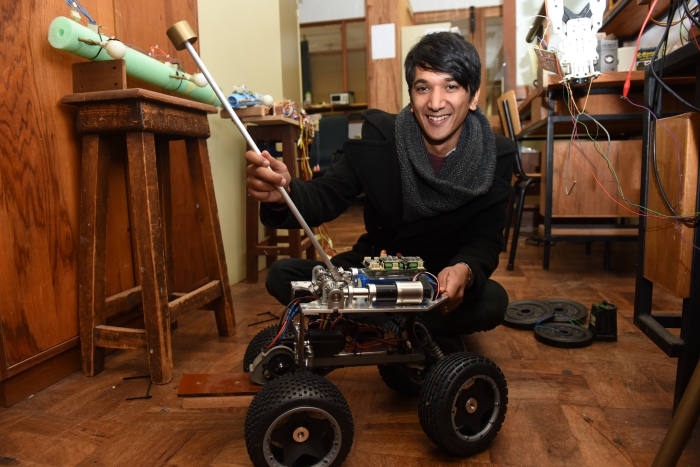Cheetah’s tail a blueprint for manoeuvrability in robots

Robotics designer Dr Amir Patel (electrical engineering) is one of six UCT scholars who received a Claude Leon Merit Award for 2016. He spoke with Helen Swingler about how the award supports his research and academic career – and why he puts cheetah fur in a wind tunnel.

HS: What drew you to electrical engineering?
AP: As a young boy I was fascinated by animals – particularly dinosaurs! – and then in high school I discovered robotics and I’ve been hooked ever since. I love that robotics – and physics in general – can describe the motion of these creatures.
HS: Describe your academic journey.
AP: I did my undergrad in mechatronics engineering at UCT, graduating in 2008. I joined Tellumat Defence (2009) and worked on flight-control systems for unmanned aerial vehicles – or UAVs. In 2010 my employers encouraged me to do a master’s in collision avoidance for UAVs, which I did part-time, graduating in 2011. In 2012, while at Tellumat, UCT approached me to lecture a course part-time. The Department of Electrical Engineering then offered me a position as an assistant lecturer. Part of my contract with UCT was that I complete my PhD within three years. After many late nights, I got my doctorate in mechatronics in June 2015 and shortly afterwards I was offered a permanent appointment.
HS: Your current research involves cheetahs. What are they teaching you?
AP: My primary research goal is to understand rapid manoeuvrability in quadrupeds, or four-legged animals. Specifically, my PhD research involved studying the motion of the cheetah tail and how this can be applied to designing more agile robots. However, I was always missing high-fidelity data from live cheetahs. So, the Claude Leon award will fund the placement of novel sensors on captive cheetahs – on both tail and spine – to obtain this missing information.
HS: As a researcher, what floats your boat?
AP: I love having the freedom to explore new ideas. For example, I’ve just written a paper on the aerodynamics of the cheetah tail where we put cheetah fur in a wind tunnel! Contrary to common belief, we did this because the cheetah tail is quite lightweight (~2%) and the fur makes up most of the volume. We discovered that the aerodynamic drag created by the tail fur can also assist the cheetah when manoeuvring!
HS: What do your academic responsibilities entail besides research? Lecturing? Supervising?
AP: I lecture two third-year engineering courses: embedded systems and mechatronics design. I also currently supervise two PhD and three master’s students.
HS: Is the recognition that the Claude Leon award brings important to an early career academic?
AP: It’s very important! When you start in academia, it’s an uphill battle initially. You generally have no funding and you’re too fresh to have many contacts or collaborators to provide the finances. This sort of award is great because it recognises that struggle.
HS: What do you like doing off duty?
AP: I love listening to music and I also dabble with making electronic music on my laptop.
Read more about what the Department of Engineering gets up to
Story Helen Swingler. Photo Michael Hammond.